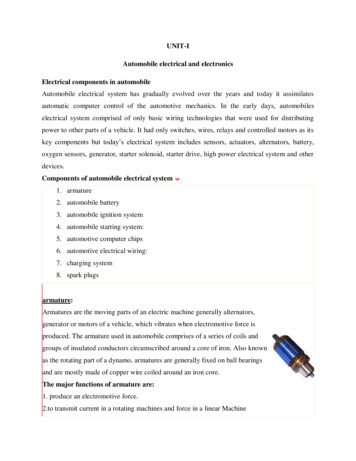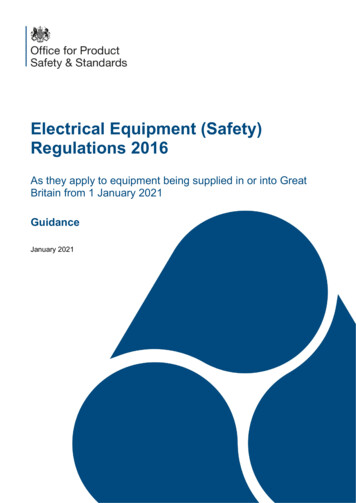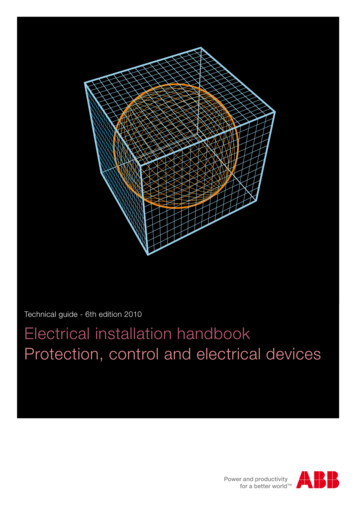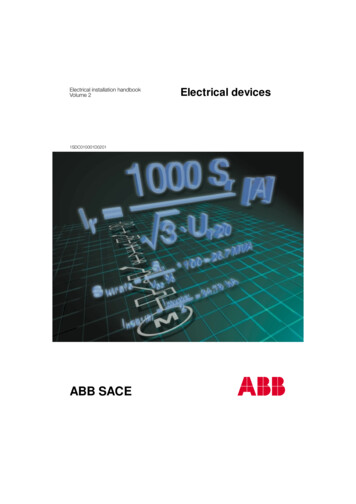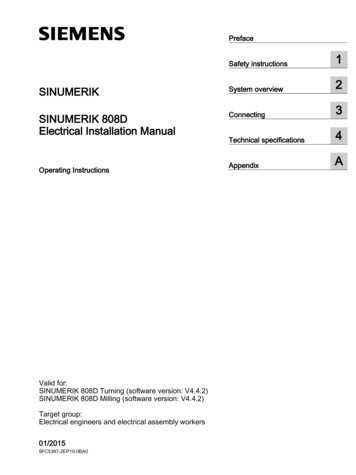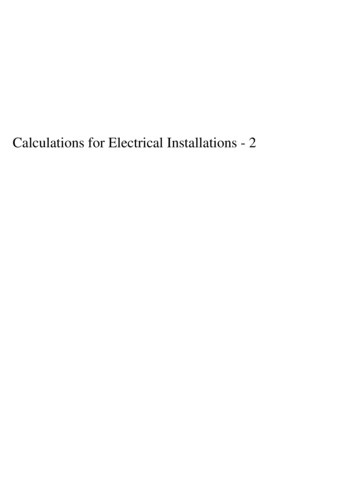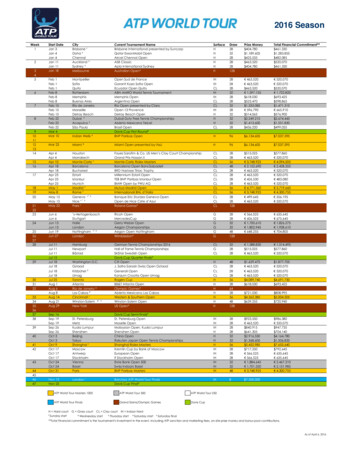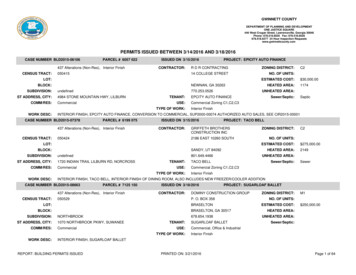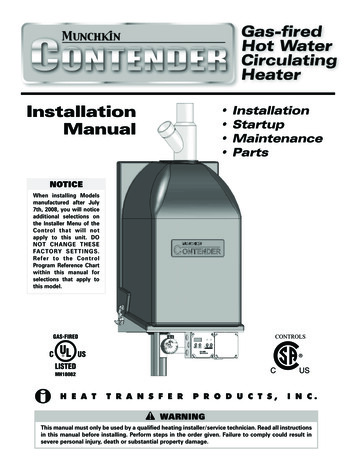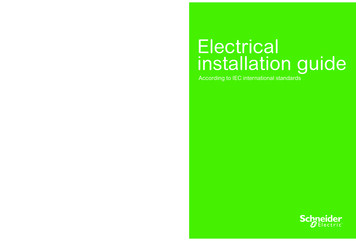
Transcription
2016Electricalinstallation guideElectrical installation guideAccording to IEC international standards35, rue Joseph MonierCS30323F-92506 Rueil-Malmaison CedexRCS Nanterre 954 503 439Capital social 928 298 512 s standards, specifications and designs change from time to time, please ask for confirmation ofthe information given in this pubication. Schneider Electric Industries SASThis document has beenprinted on ecological paper 01/2016
This guide has been written for electrical Engineers who have to design,select electrical equipment, install these equipment and, inspect ormaintain low-voltage electrical installations in compliance with internationalStandards of the International Electrotechnical Commission (IEC).“Which technical solution will guarantee that all relevant safety rules aremet?” This question has been a permanent guideline for the elaboration ofthis document.An international Standard such as the IEC 60364 series “Low voltageElectrical Installations” specifies extensively the rules to comply with toensure safety and correct operational functioning of all types of electricalinstallations. As the Standard must be extensive, and has to be applicableto all types of equipment and the technical solutions in use worldwide, thetext of the IEC rules is complex, and not presented in a ready-to-use order.The Standard cannot therefore be considered as a working handbook, butonly as a reference document.The aim of the present guide is to provide a clear, practical and stepby-step explanation for the complete study of an electrical installation,according to IEC 60364 series and other relevant IEC Standards. The firstchapter (A) presents the methodology to be used, and refers to all chaptersof the guide according to the different steps of the study.We all hope that you, the reader, will find this handbook genuinely helpful.Schneider Electric S.A.This technical guide is the result of a collectiveeffort. Responsible for the coordination of thisedition: Laurent MISCHLERThe Electrical Installation Guide is a single document covering thetechniques and standards related to low-voltage electrical installations.It is intended for electrical professionals in companies, design offices,inspection organisations, etc.Edition: 2016This Technical Guide is aimed at professional users and is only intendedto provide them guidelines for the definition of an industrial, tertiary ordomestic electrical installation. Information and guidelines contained in thisGuide are provided AS IS. Schneider Electric makes no warranty of anykind, whether express or implied, such as but not limited to the warrantiesof merchantability and fitness for a particular purpose, nor assumes anylegal liability or responsibility for the accuracy, completeness, or usefulnessof any information, apparatus, product, or process disclosed in this Guide,nor represents that its use would not infringe privately owned rights.The purpose of this guide is to facilitate the implementation of Internationalinstallation standards for designers & contractors, but in all cases theoriginal text of International or local standards in force shall prevail.Price: 60 ISBN: 978.2.9531643.3.6N dépôt légal: 1er semestre 2008 Schneider ElectricAll rights reserved in all countriesThis new edition has been published to take into account changes intechniques, standards and regulations, in particular electrical installationstandard IEC 60364 series.We thank all the readers of the previous edition of this guide for theircomments that have helped improve the current edition.We also thank the many people and organisations, too numerous to namehere, who have contributed in one way or another to the preparation of thisguide.
AcknowlegementsThis guide has been realized by a team ofexperienced international experts, on the baseof IEC 60364 series of standard, and include thelatest developments in electrical standardization.We shall mention particularly the followingexperts and their area of expertise:ChapterChristianCollombetD, GBernardJoverJacquesSchonekD, G, L, M, , PEricBettegaEPascalLepretreEEmmanuelGenevrayE, etGGeoffroyDe-LabrouheKJean tthieuGuillotJean-François ReyThierryCorménierFranckGruffazL, MNN, AHF, H, PFBK, S
Tools for more efficiencyin electrical installation designElectrical installation WikiThe Electrical Installation Guide is also available on-line as a wikiin 4 languages: in Englishen.electrical-installation.org in Russianru.electrical-installation.org in Chinesecn.electrical-installation.org in Our experts constantly contribute to its evolution. Industry and academicprofessionals can collaborate too!ChineseGermanPower Management BlogIn the Schneider Electric blog, you will find the best tips about standards, tools,software, safety and latest technical news shared by our experts. You will findeven more information about innovations and business opportunities. This isyour place to leave us your comments and to engage discussion about yourexpertise. You might want to share with your Twitter or LinkedIn ment-metering-monitoring-power-qualitySchneider Electric - Electrical installation guide 2016
Online Electrical calculation ToolsA set of tools designed to help you:ppdisplay on one chart the time-current curves of different circuit-breakers or fusesppcheck the discrimination between two circuit-breakers or fuses, or two ResidualCurrent devices (RCD), search all the circuit-breakers or fuses that can beselective/cascading with a defined circuit-breaker or fuseppcalculate the Cross Section Area of cables and build a cable scheduleppcalculate the voltage drop of a defined cable and check the maximum lengthOnline l Advanced Calculation 4The new Ecodial Advanced Calculation 4 software is dedicated to electricalinstallation calculation in accordance with IEC60364 international standard ornational standards.This 4th generation offers new features like:pp management of operating mode (parallel transformers, back-up generators )pp discrimination analysis associating curves checking and discrimination tables,direct access to protection settingsSchneider Electric - Electrical installation guide 2016
Electrical installation guide 2016ForewordEtienne TISON, International Electrotechnical Commission (IEC) TC64Chairman.The task of the IEC Technical Committee 64 is to develop and keep up-todate requirements- for the protection of persons against electrical shock, and- for the design, verification and implementation of low voltage electricalinstallations.Series of standard such as IEC 60364 developed by IEC TC64 isconsidered by the international community as the basis of the majority ofnational low-voltage wiring rules.IEC 60364 series is mainly focussed on safety due the use of electricity bypeople who may not be aware of risk resulting from the use of electricity.But modern electrical installations are increasingly complex, due to externalinput such as- electromagnetic disturbances- energy efficiency- .Consequently, designers, installers and consumers need guidance on theselection and installation of electrical equipment.Schneider Electric has developed this Electrical Installation Guidededicated to low voltage electrical installations. It is based on IEC TC64standards such as IEC 60364 series and provides additional informationin order to help designers, contractors and controllers for implementingcorrect low-voltage electrical installations.As TC64 Chairman, it is my great pleasure and honour to introduce thisguide. I am sure it will be used fruitfully by all persons involved in theimplementation of all low-voltage electrical installations.Etienne TISONEtienne TISON has been working with SchneiderElectric since 1978. He has been always involvedis various activities in low voltage field.In 2008, Etienne TISON has been appointedChairman of IEC TC64 as well as Chairman ofCENELEC TC64.
General rules of electricalinstallation designAConnection to the MV utilitydistribution networkBConnection to the LV utilitydistribution networkCMV & LV architecture selectionguide for buildingsDLV DistributionEProtection against electricshocks and electric firesFSizing and protection ofconductorsGLV switchgear: functions &selectionHOvervoltage protectionJEnergy efficiency in electricaldistributionKPower Factor CorrectionLHarmonic managementMCharacteristics of particularsources and loadsNPhotovoltaic installationsPResidential and other speciallocationsQEMC guidelinesRMeasurementS
This guide has been written for electrical Engineers who have to design,select electrical equipment, install these equipment and, inspect ormaintain low-voltage electrical installations in compliance with internationalStandards of the International Electrotechnical Commission (IEC).“Which technical solution will guarantee that all relevant safety rules aremet?” This question has been a permanent guideline for the elaboration ofthis document.An international Standard such as the IEC 60364 series “Low voltageElectrical Installations” specifies extensively the rules to comply with toensure safety and correct operational functioning of all types of electricalinstallations. As the Standard must be extensive, and has to be applicableto all types of equipment and the technical solutions in use worldwide, thetext of the IEC rules is complex, and not presented in a ready-to-use order.The Standard cannot therefore be considered as a working handbook, butonly as a reference document.The aim of the present guide is to provide a clear, practical and stepby-step explanation for the complete study of an electrical installation,according to IEC 60364 series and other relevant IEC Standards. The firstchapter (A) presents the methodology to be used, and refers to all chaptersof the guide according to the different steps of the study.We all hope that you, the reader, will find this handbook genuinely helpful.Schneider Electric S.A.This technical guide is the result of a collectiveeffort. Responsible for the coordination of thisedition: Laurent MISCHLERThe Electrical Installation Guide is a single document covering thetechniques and standards related to low-voltage electrical installations.It is intended for electrical professionals in companies, design offices,inspection organisations, etc.Edition: 2015This Technical Guide is aimed at professional users and is only intendedto provide them guidelines for the definition of an industrial, tertiary ordomestic electrical installation. Information and guidelines contained in thisGuide are provided AS IS. Schneider Electric makes no warranty of anykind, whether express or implied, such as but not limited to the warrantiesof merchantability and fitness for a particular purpose, nor assumes anylegal liability or responsibility for the accuracy, completeness, or usefulnessof any information, apparatus, product, or process disclosed in this Guide,nor represents that its use would not infringe privately owned rights.The purpose of this guide is to facilitate the implementation of Internationalinstallation standards for designers & contractors, but in all cases theoriginal text of International or local standards in force shall prevail.Price: 60 ISBN: 978.2.9531643.3.6N dépôt légal: 1er semestre 2008 Schneider ElectricAll rights reserved in all countriesThis new edition has been published to take into account changes intechniques, standards and regulations, in particular electrical installationstandard IEC 60364 series.We thank all the readers of the previous edition of this guide for theircomments that have helped improve the current edition.We also thank the many people and organisations, too numerous to namehere, who have contributed in one way or another to the preparation of thisguide.
General contentsABCDEFGGeneral rules of electrical installation design1234MethodologyRules and statutory regulationsInstalled power loads - CharacteristicsPower loading of an installationConnection to the MV utility distribution network1 Power supply at medium voltage2 Procedure for the establishment of a new substation3 Protection against electrical hazards, faults and mis-operationsin electrical installations4 The consumer substation with LV meteriang5 The consumer substation with MV metering6 Choice and use of MV equipment and MV/LV transformer7 Substation including generators and parallel operation of transformers8 Types and constitution of MV/LV distribution substationsConnection to the LV utility distribution network1 Low-voltage utility distribution networks2 Tariffs and meteringMV & LV architecture selection guide for buildings1 Stakes of architecture design2 Simplified architecture design process3 Electrical installation characteristics4 Technological characteristics5 Architecture assessment criteria6 Choice of architecture fundamentals7 Choice of architecture details8 Choice of equipment9 Recommendations for architecture optimization10 Glossary11 Example: electrical installation in a printworksLV Distribution1 Earthing schemes2 The installation system3 External influencesProtection against electric shocks and electric fire123456789GeneralProtection against direct contactProtection against indirect contactProtection of goods in case of insulation faultImplementation of the TT systemImplementation of the TN systemImplementation of the IT systemResidual current devices (RCDs)Arc Fault Detection Devices (AFDD)Sizing and protection of 3F29F36F431 General2 Practical method for determining the smallest allowablecross-sectional area of circuit conductors3 Determination of voltage drop4 Short-circuit current5 Particular cases of short-circuit current6 Protective earthing conductor (PE)7 The neutral conductorG2G78 Worked example of cable calculationG45Schneider Electric - Electrical installation guide 2016G19G23G29G36G41
General contentsHLV switchgear: functions & selection1234The basic functions of LV switchgearThe switchgearChoice of switchgearCircuit breakerH2H5H10H115 Maintenance of low voltage switchgearH32JOvervoltage protectionKEnergy Efficiency in electrical distributionLPower Factor CorrectionMHarmonic management123456Overvoltage of atmospheric originPrinciple of lightning protectionDesign of the electrical installation protection systemInstallation of SPDsApplicationTechnical supplements1 Energy Efficiency in brief2 Energy efficiency and electricity3 Diagnostics through electrical measurement4 Energy saving opportunities5 How to evaluate energy savings1 Power factor and Reactive power2 Why to improve the power factor?3 How to improve the power factor?4 Where to install power factor correction capacitors?5 How to determine the optimum level of compensation?6 Compensation at the terminals of a transformer7 Power factor correction of induction motors8 Example of an installation before and after power-factor correction9 The effects of harmonics10 Implementation of capacitor banks1 The problem: why is it necessary to manage harmonics?2 Definition and origin of harmonics3 Essential indicators of harmonic distortionand measurement principles4 Harmonic measurement in electrical networks5 Main effects of harmonics in electrical installations6 Standards7 Solutions to mitigate harmonicsNCharacteristics of particular sources and loadsPPhotovoltaic installations12345Protection of a LV generator set and the downstream circuitsUninterruptible Power Supply units (UPS)Protection of LV/LV transformersLighting circuitsAsynchronous motors1 Benefits of photovoltaic energy2 Background and technology3 PV System and Installation Rules4 PV installation architectures5 MonitoringSchneider Electric - Electrical installation guide 16P29
General contentsQRSResidential and other special locations1 Residential and similar premises2 Bathrooms and showers3 Recommendations applicable to special installations and locationsEMC guidelines12345Electrical distributionEarthing principles and structuresImplementationCoupling mechanisms and counter-measuresWiring recommendationsMeasurement1 Measurement applications2 Description of applications3 Focus on IEC 61557-12 standardSchneider Electric - Electrical installation guide 2016Q2Q8Q12R2R3R5R20R26S2S3S7
Schneider Electric - Electrical installation guide 2016
Chapter AGeneral rules of electricalinstallation designA1Contents34MethodologyA2Rules and statutory regulationsA52.1 Definition of voltage ranges2.2 Regulations2.3 Standards2.4 Quality and safety of an electrical installation2.5 Initial testing of an installation2.6 Put in out of danger the existing electrical installations2.7 Periodic check-testing of an installation2.8 Conformity assessement (with standards and specifications)of equipment used in the installation2.9 EnvironmentA5A6A6A7A8A8A9Installed power loads - CharacteristicsA113.1 Induction motors3.2 Resistive-type heating appliances and incandescent lamps(conventional or halogen)3.3 Fluorescent lamps3.4 Discharge lampsA113.5 LED lamps & fixturesA16Power loading of an 3Installed power (kW)Installed apparent power (kVA)Estimation of actual maximum kVA demandExample of application of factors ku and ksChoice of transformer ratingChoice of power-supply sourcesA9A10A13A14A15 Schneider Electric - all rights reserved12Schneider Electric - Electrical installation guide 2016
A - General rules of electrical installation design1 MethodologyA2For the best results in electrical installation design it is recommended to readand to use all the chapters of this guide in the order in which they are presented.A - General rules of electrical installation designRules and statutory regulations Schneider Electric - all rights reservedRange of low-voltage extends from 0 V to 1000 V in a.c. and from 0 V to 1500 Vin d.c. One of the first decision is the selection of type of current between thealternative current which corresponds to the most common type of current throughout the world and the direct current. Then designers have to select the mostappropriate rated voltage within these ranges of voltages. When connected to aLV public network, the type of current and the rated voltage are already selectedand imposed by the Utility.Compliance with national regulations is then the second priority of the designersof electrical installation. Regulations may be based on national or internationalstandards such as the IEC 60364 series.Selection of equipment complying with national or international product standardsand appropriate verification of the completed installation is a powerful meanfor providing a safe installation with the expected quality. Defining and complyingwith the verification and testing of the electrical installation at its completion as wellas periodic time will guarantee the safety and the quality of this installation all alongits life cycle. Conformity of equipment according to the appropriate product standardsused within the installation is also of prime importance for the level of safetyand quality.Environmental conditions will become more and more stringent and will needto be considered at the design stage of the installation. This may include nationalor regional regulations considering the material used in the equipment as well asthe dismantling of the installation at its end of life.A§3 - Installed power loads - CharacteristicsA§4 - Power loading of an installationInstalled power loads - CharacteristicsB - Connection to the MV utility distributionnetworkConnection to the MV public distribution networkC - Connection to the LV utility distributionnetworkConnection to the LV utility distribution networkD - MV & LV architecture selection guideMV & LV architecture selection guideA review of all applications needing to be supplied with electricity is to be done. Anypossible extensions or modifications during the whole life of the electrical installationare to be considered. Such a review aimed to estimate the current flowing in eachcircuit of the installation and the power supplies needed.The total current or power demand can be calculated from the data relativeto the location and power of each load, together with the knowledge of the operatingmodes (steady state demand, starting conditions, non simultaneous operation, etc.)Estimation of the maximum power demand may use various factors dependingon the type of application; type of equipment and type of circuits used within theelectrical installation.From these data, the power required from the supply source and (where appropriate)the number of sources necessary for an adequate supply to the installation is readilyobtained.Local information regarding tariff structures is also required to allow the best choiceof connection arrangement to the power-supply network, e.g. at medium voltageor low voltage level.Where this connection is made at the Medium Voltage level a consumer-typesubstation will have to be studied, built and equipped. This substation may bean outdoor or indoor installation conforming to relevant standards and regulations(the low-voltage section may be studied separately if necessary). Meteringat medium-voltage or low-voltage is possible in this case.Where the connection is made at the Low Voltage level the installation will beconnected to the local power network and will (necessarily) be metered accordingto LV tariffs.The whole electrical system including the MV installation and the LV installationis to be studied as a complete system. The customer expectations and technicalparameters will impact the architecture of the system as well as the electricalinstallation characteristics.Determination of the most suitable architecture of the MV/LV main distribution andLV power distribution level is often the result of optimization and compromise.Neutral earthing arrangements are chosen according to local regulations, constraintsrelated to the power-supply, and to the type of loads.Schneider Electric - Electrical installation guide 2016
1 MethodologyA3The distribution equipment (panelboards, switchgears, circuit connections, .)are determined from building plans and from the location and grouping of loads.The type of premises and allocation can influence their immunity to externaldisturbances.LV distributionE - LV DistributionThe system earthing is one protective measure commonly used for the protectionagainst electric shocks. These systems earthings have a major impact on theLV electrical installation architecture and they need to be analysed as earlyas possible. Advantages and drawbacks are to be analysed for a correct selection.Another aspect needing to be considered at the earlier stage is the externalinfluences. In large electrical installation, different external influences may beencountered and need to be considered independently. As a result of these externalinfluences proper selection of equipment according to their IP or IK codes has to bemade.F - Protection against electric shocks & electricfiresProtection against electric shocks & electric firesProtection against electric shock consists in providing provision for basic protection(protection against direct contact) with provision for fault protection (protectionagainst indirect contact). Coordinated provisions result in a protective measure.One of the most common protective measures consists in “automatic disconnectionof supply” where the provision for fault protection consists in the implementationof a system earthing. Deep understanding of each standardized system (TT, TNand IT system) is necessary for a correct implementation.Electrical fires are caused by overloads, short circuits and earth leakage currents,but also by electric arcs in cables and connections. These dangerous electric arcsare not detected by residual current devices nor by circuit breakers or fuses. Thearc fault detector technology makes it possible to detect dangerous arcs and thusprovide additional protection of installations. See chapter F §9 for more information.G - Sizing and protection of conductorsSizing and protection of conductorsSelection of cross-sectional-areas of cables or isolated conductors for lineconductors is certainly one of the most important tasks of the design process ofan electrical installation as this greatly influences the selection of overcurrentprotective devices, the voltage drop along these conductors and the estimation ofthe prospective short-circuit currents: the maximum value relates to the overcurrentprotection and the minimum value relates to the fault protection by automaticdisconnection of supply. This has to be done for each circuit of the installation.Similar task is to be done for the neutral conductor and for the Protective Earth (PE)conductor.H - LV switchgear: functions & selectionLV switchgear: functions & selectionOnce the short-circuit current are estimated, protective devices can be selected forthe overcurrent protection. Circuit breakers have also other possible functions suchas switching and isolation. A complete understanding of the functionalities offered byall switchgear and controlgear within the installation is necessary. Correct selectionof all devices can now be done.A comprehensive understanding of all functionalities offered by the circuit breakersis of prime importance as this is the device offering the largest variety of functions.J - Overvoltage protectionOvervoltage protectionK – Energy efficiency in electrical distributionEnergy efficiency in electrical distributionImplementation of active energy efficiency measures within the electrical installationcan produce high benefits for the user or owner: reduced power consumption,reduced cost of energy, better use of electrical equipment. These measures willmost of the time request specific design for the installation as measuring electricityconsumption either per application (lighting, heating, process ) or per area (floor,workshop) present particular interest for reducing the electricity consumption stillkeeping the same level of service provided to the user.Schneider Electric - Electrical installation guide 2016 Schneider Electric - all rights reservedDirect or indirect lightning strokes can damage electrical equipment at a distanceof several kilometres. Operating voltage surges, transient and industrial frequencyover-voltage can also produce the same consequences. All protective measuresagainst overvoltage need to be assessed. One of the most used correspondsto the use of Surge Protective Devices (SPD). Their selection; installationand protection within the electrical installation request some particular attention.
A - General rules of electrical installation design1 MethodologyL - Power Factor CorrectionReactive energyA4The power factor correction within electrical installations is carried out locally,globally or as a combination of both methods. Improving the power factor has adirect impact on the billing of consumed electricity and may also have an impact onthe energy efficiency.M - Harmonic managementHarmonicsHarmonic currents in the network affect the quality of energy and are at the originof many disturbances as overloads, vibrations, ageing of equipment, troubleof sensitive equipment, of local area networks, telephone networks. This chapterdeals with the origins and the effects of harmonics and explain how to measure themand present the solutions.N - Characteristics of particular sources andloadsParticular supply sources and loadsP - Photovoltaic InstallationsA green and economical energyParticular items or equipment are studied:b Specific sources such as alternators or invertersb Specific loads with special characteristics, such as induction motors, lightingcircuits or LV/LV transformersb Specific systems, such as direct-current networks.The solar energy development has to respect specific installation rules.Generic applicationsQ - Residential and other special locationsCertain premises and locations are subject to particularly strict regulations: the mostcommon example being residential dwellings.EMC GuidelinesR - EMC guidelinesSome basic rules must be followed in order to ensure Electromagnetic Compatibility.Non observance of these rules may have serious consequences in the operationof the electrical installation: disturbance of communication systems, nuisancetripping of protection devices, and even destruction of sensitive devices.S - MeasurementMeasurementMeasurement is becoming more and more an essential part of the electricalinstallations. Chapter S is an introduction to the different applications ofmeasurements, such as energy efficiency, energy usage analysis, billing, costallocation, power quality . It also provides a panorama of the relevant standardsfor these applications, with a special focus on the IEC 61557-12 related to PowerMetering and monitoring devices (PMD).A companion tool ofthe Electrical Installation GuideEcodial softwareEcodial software(1) provides a complete design package for LV installations,in accordance with IEC standards and recommendations. Schneider Electric - all rights reservedThe following features are included:b Construction of one-line diagramsb Calculation of short-circuit currents according to several operating modes (normal,back-up, load shedding)b Calculation of voltage dropsb Optimization of cable sizesb Required ratings and settings of switchgear and fusegearb Discrimination of protective devicesb Optimization of switchgear using cascadingb Verification of the protection of people and circuitsb Comprehen
The Electrical Installation Guide is a single document covering the techniques and standards related to low-voltage electrical installations. It is intended for electrical professionals in

